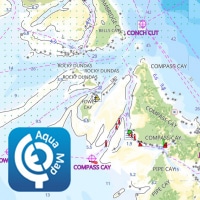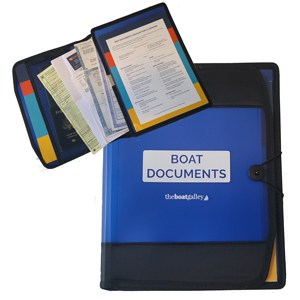I didn’t intend to write about our bilge alarm today. Sometimes life makes choices for you.
We were doing our normal morning stuff aboard Barefoot Gal. I was replying to some emails and Dave had just brushed his teeth. And suddenly was a loud whistle noise coming from the port side of the boat. The bilge alarm??
Yep.
Dave was standing right over the bilge access panel and looked in. He was rather shocked to find a couple of inches of water in the bilge, which is normally totally dry (Barefoot Gal is a catamaran, there’s no stuffing box and her bilges are very shallow). We typically check it every few days and there is just never anything in it.
The water wasn’t yet deep enough for the automatic bilge pump to kick on yet. But the alarm had let us know that we needed to check out a potential problem.
And so we’re checking. The first thing to check in a situation like this is whether the water is fresh or salt, so you know where to start looking. And next check the rate of flow.
Our leak is nothing that is going to sink the boat, that much was immediately clear. After a full day of checking, we know lots of things that it’s not. We’ve checked all the potentially big problem areas and they’re not problems. We finally have concluded that there was a tiny crack in a water hose where it went on a hose barb. We’ve fixed that and will see if any more water appears. We’re now checking the bilge every 30 minutes. But really, the source of the water isn’t the topic of this article.
What I want to write about here is the importance of having a bilge alarm. It let us know there was a problem even before the bilge pump kicked on — had it been a big problem, even a few minutes early warning could have been critical.
Twice on our previous boat, our bilge alarm alerted us to problems: once an improperly replaced stuffing box after we’d been on the hard and another time that we had a pinhole leak in our fresh water tank.
You can do bilge alarms several different ways:
- Wire it into the bilge pump circuit so that if the bilge pump goes on, the alarm will sound (what we had on our previous boat)
- Put it on a separate circuit with a float switch to trip it (two fewer connections in the bilge circuit; fewer possible points of failure; also can possibly mount the float switch lower than float switch for bilge pump)
- Use a separate battery-powered water alarm (very easy to install, but not nearly the battery life or loudness of one that’s wired into the house batteries . . . but also won’t drain the house batteries if the bilge pump is needed and easy to turn off the alarm whereas hard-wired ones can’t be unless you install a switch)
- There are also stand-alone alarms that can send a message to a cell phone if you keep your boat at a marina where wifi is available (they’ll also let you know if power or wifi goes down). These are good if you only occasionally stay on the boat so that you know of a problem when you’re not there.
We opted for a “hot water heater” alarm that runs on a 9-volt battery. It’s not as loud as some others, but still loud enough that we can hear it over the diesel engine. We like that in an emergency, we can silence it by drying the contacts or just pulling the battery. While we like having an alarm tell us of a problem, we do not like one constantly sounding as we are troubleshooting! It says that one battery will last up to 5 years and the alarm will sound for 3 days if activated; just to be on the safe side, we use a lithium 9 volt battery and replace it every year on our anniversary (the old one gets put into a blood pressure cuff where we’ll see if it dies).
You can buy 12 volt or battery-powered alarms many places, such as automotive, hardware or home improvement stores. There are probably hundreds of different models available and they’re quite inexpensive for the peace of mind. Marine stores also sell more expensive “marine” alarms, and I honestly don’t see that they are any better. For both boats, we’ve bought alarms on Amazon:
- 12 volt 85 decibel alarm (2-pack; we used a predecessor model on Que Tal)
- 9-volt battery water alarm (what we are now using on Barefoot Gal)
- Lithium 9-volt batteries
I have not used an alarm that sends a message, but a guy that stopped by our booth did tell me about one they were using while I was at the Annapolis Sailboat Show. A particularly nice feature of this one is that it is powered by a cord that plugs into a USB socket, which most boats have. Then you simply need a reasonably good wifi connection (not a hotspot from your phone which will not be available when you take your phone off the boat).

Carolyn Shearlock has lived aboard full-time for 17 years, splitting her time between a Tayana 37 monohull and a Gemini 105 catamaran. She’s cruised over 14,000 miles, from Pacific Mexico and Central America to Florida and the Bahamas, gaining firsthand experience with the joys and challenges of life on the water.
Through The Boat Galley, Carolyn has helped thousands of people explore, prepare for, and enjoy life afloat. She shares her expertise as an instructor at Cruisers University, in leading boating publications, and through her bestselling book, The Boat Galley Cookbook. She is passionate about helping others embark on their liveaboard journey—making life on the water simpler, safer, and more enjoyable.
Here’s your “Quick Start” to everything you need to know when living on a boat:











Dana LeTourneau says
Hello Carolyn and Dave,
I’ve had a bilge pump alarm on my boat for the past 18 years. On our Valiant 40, we have a small sump in the bilge that collects water first. In that sump is a small 500gph pump with a float switch. I wired the actual alarm to the auto-off-manual bilge switch near the nav station.
Having a bilge alarm saved my bacon twice this year. The first was when my old PSS dripless packing gland failed while the bottom cleaner was doing his job in Bocas Marina, Panama, I hadn’t run the engine in a few months (my bad) and when he rotated the prop, the seal failed. The second timed, while lifting the anchor in Isla Provedencia, Colombia, the stainless collar of the new PSS dripless packing gland slipped forward.
In both instances, I knew I had trouble when the alarm didn’t quit after 10 seconds or so. The alarm is loud enough for me to hear in the cockpit with the diesel engine running. Never leave home without one.
Best to Paws,
Dana
s/v Paradiso, now in Jacksonville, FL
Eric says
Hi Carolyn,
Excellent low cost insurance idea! I think I will install the 9V “hot water heater” alarm and be sure to buy through your link. I’m wondering if you have an installation tips or perhaps could show pictures of how you mounted the main unit and how you mounted the sensor? Did you fasten the cables somehow or just let them lay free in the bilge.
Thanks so much!
Eric
Sailing Out Of Sight says
Thanks for publishing this article. We upgraded to a dual automatic bilge pump installation and a third manual pump yet Installing a bilge water alarm is one of our remaining tasks and this article helped us identify some good options.